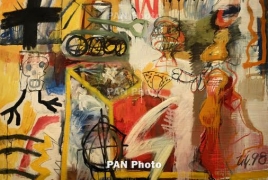 Kamo Nigaryan’s silent dialogueModest artist with great heritage When writing about painter Kamo Nigaryan, you come across some paradox, which can be compared to the feelings of an archaeologist who discovers an unknown object. He tries to understand the structure of the finding, its style and date of creation, as well as get any information about it. However, failing to find any info, the scientist produces his own conclusion, basing on his experience and impression from the discovery. No one knows how precise the conclusion is and there is a lot of room for speculation. PanARMENIAN.Net - There was a painter and designer Kamo Nigaryan, who was born in 1959 and died in 2011, leaving much heritage but little information about himself. Like in case with the unknown finding, we can judge about his works relying on our own experience and the vivid asocial conjunctions of his works. This man didn’t like to attract attention towards his personality and never gave any interview. Freshness of imagination and intuition allowed him to feel the technocratic trends. During the 1970s he created characters of the future, like virtual satellite, brain- controlled sensor artificial limbs, and the internet. He preferred to express his ideas through art, with the help of symbols, which he drew basing on his personal views. Rejecting to comment on his works, Kamo gifted the other the opportunity to comprehend the drawings and make conclusions by themselves. Without hinting at the real meaning of his creations, he created a world, where each spectator can form his own opinion. Nigaryan worked on the brink of genres: abstractionism and surrealism that gradually transformed into art brut (a French term that translates as 'raw art', invented by the French artist Jean Dubuffet to describe art such as graffiti or naïve art which is made outside the academic tradition of fine art.) In his world, real becomes unreal while unreal grows into schizophrenia, which shows the opposite side of the standards. The creating spirit is the winner in this world. Naming series of his paintings Schizomilitary and Shizosafari (Icons of Ruined Times, 1977-1985), he featured the fundamental idea of sanctity, the development of which had stopped. In the world of monsters, some human nature can still be observed behind ugly masks and malformed muscles. These series can be interpreted differently and everyone will see his own reality. However, the real meaning of the drawings will still remain unknown. Each of Niganyan’s series is different and at the same time has a common “genetic link” of the artist’s ideological space: from black and white (Protoforms) to colorful, from simple lines of a childish drawing to well-formed pictures, from archaic pictograms (Notes from Past and Future series) to From A to Z (Abrakadabra series). As we have already said, Niganyan’s activity was not reduced to painting art. During several years of cooperation with the All-Union Scientific Research Institute for Technical Aesthetics, he authored 14 industrial patents notable for original solutions and specific meaning. Here is an extract from his description of an elevator keyboard (1977): “Although an elevator is called ‘a vertical transport, we think that the mankind still measures its path in horizontals but not verticals. In buildings, these verticals are disjoined with a certain number of stairs; that is why the keys are placed cornerwise. The idea of ‘vertical transport’ will possibly be acceptable for a generation which will live (?) under the sky. However, we still feel comfortable on the earth.” Special attention should be paid to photographs developed with a special technique and presenting abstract imahes of “premonitions that came true.” In 1984, he created a series called Explosion. The shooting took place in Leninakan (now Gyumri) four years before the earthquake. The special method of negative development allowed to get a kind of ‘explosive’ images. The 1988 quake that destroyed Spitak and Leninakan directly (?) or indirectly (?) proved that a piece of art can be result of intuition. Nigaryan is a unique, innovatively ambiguous and global figure. He is a phenomenon that should be understood and accepted. Anyhow, “the truth will bulge out of your works,” as Nigaryan wrote in his manifesto of innermost thoughts about the art. Biographical background Nigaryan was born in Helendorf (Gardmank region of historical Armenia, presently in Azerbaijan) into a family of intellectuals in 1950. He graduated from the department of design at Yerevan’s Institute of Fine Arts and Theatre in 1973. Working as a designer throughout his career, Nigaryan created an extensive group of theatrical, exhibition, film posters and seven museum expositions which are of exemplary importance in the history of Armenian design. His personal exhibition was hosted by Armenian Artists’ Union in 2011. Exhibition Kamo Nigaryan: Schizopolis was held at the Cafesjian Center for the Arts (CCA) in 2015. PanARMENIAN.Net / Tsets The Oscar-winning helmer who hopes to return to Armenia many, many times ICAE2018 proves a success Telling a story in a single image Chance to have another dream The other side of music How Indians turned into Armenian Gypsies Armenian Renaissance |